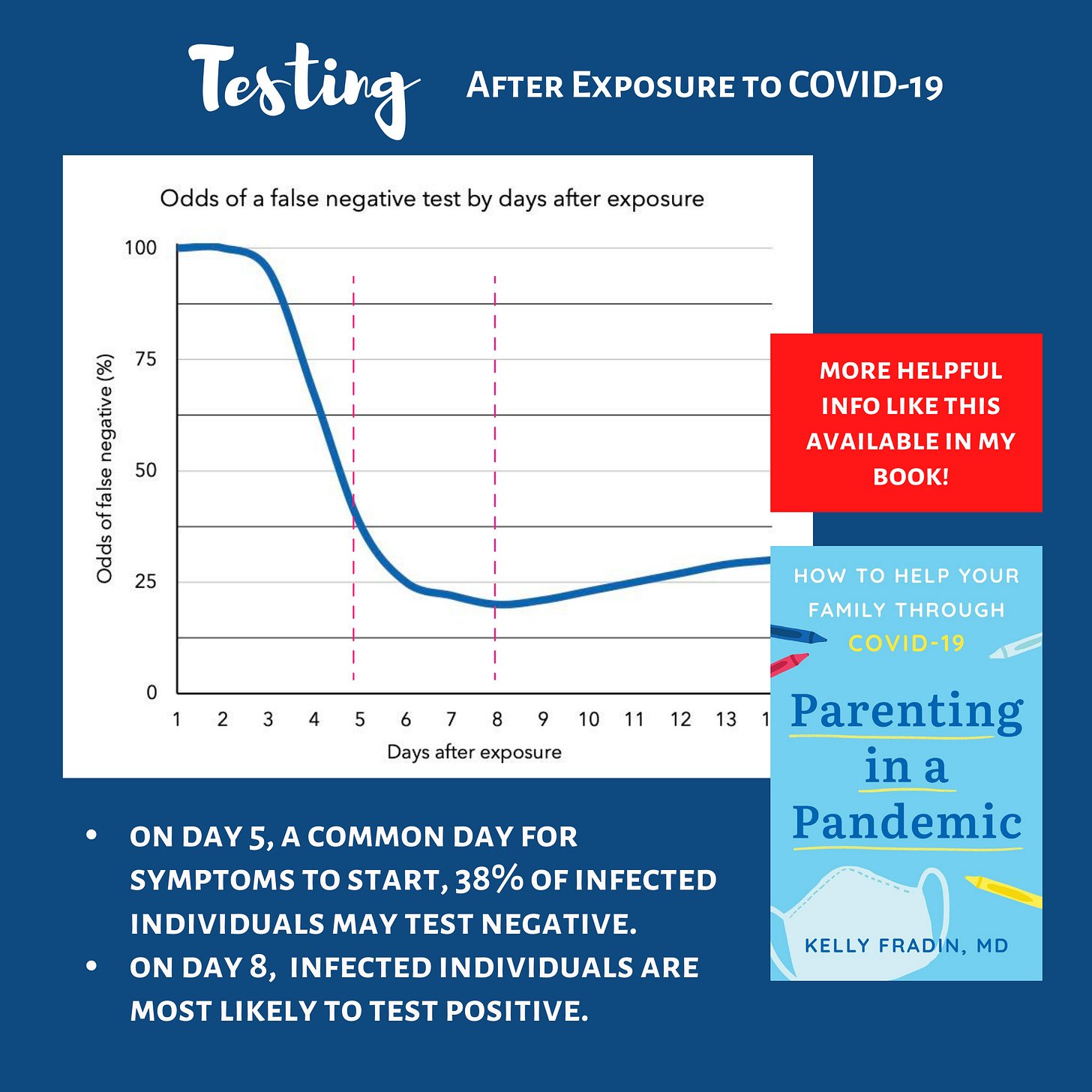My dear friend called, “We are getting together with family for the holidays, and we want to know… how long should we quarantine before testing.” She saw this chart about the best time to get tested after an exposure in my book and was trying to reconcile this information with the new guidelines.
This chart is still accurate and relevant, as it’s showing you how likely the test is to be accurate on a given day after exposure. See how much better 7 days after exposure is from 5? The new guidelines are allowing you to test as early as day 5, when we know 38% of infected individuals may test negative. How could this be?
To really solve the “how long do we quarantine question”, we need more information than just this… so read on. Remember we quarantine after an exposure not when we are sick. If you are sick, you always isolate for 10 days. If you have a known exposure OR if you have had more exposures than you want to spread COVID to high risk individuals, you quarantine.
The CDC’s new quarantine guidelines are overdue, but mean more work for us regular folk faced with making decisions especially over the holidays. How can we understand the implications of shortening quarantine?
First here is the CDC estimate of likely missed cases with the various scenarios.
The light color is the expected number of missed cases using this strategy and the bigger bar is the “worst case scenario” assuming a higher exposure load, a less accurate test or a poor specimen quality.
7 day quarantine with no test will miss between 10-22% of individuals who may be infectious.
7 day quarantine plus any test will miss ~ 5% a PCR test will miss ~4% (2.3-8.6%) or an antigen test will miss 5.5% (3.1-11.9%).
10 day quarantine with no test (just waiting for symptoms) will miss 1.4% (0.1-10.6%.) Whereas 10 days plus a PCR test will miss 0.3 (0-2.4%) or 10 days plus an antigen test will miss 1.1 (0.1-9.5%)
The gold standard quarantine of 14 days with no test will miss 0.1% (0-3%).
When thinking about the length of quarantine, it’s important to remember during quarantine you need to be on alert for subtle symptoms, even headaches or soreness.
Here I’ve put the amount of time before symptoms arise. As you can see about 75% of people have symptoms by 6.9 days. This is really helpful because those individuals aren’t counting on the test to be identified as a transmission risk.
Lastly we’ve got how long individuals are contagious if asymptomatic. This is more of a rough estimate and extrapolated data, but still helpful.
75% of asymptomatic people are infectious for no more than 7.8 days, though the period of time individuals may be infectious starts a few days after the exposure.
Considering that some individuals will be symptomatic or progressing through their period of infectiousness helps. The 7 day period reduces our dependence on the test performance. After 7 days agood number of infectious asymptomatic individuals will no longer be infectious and up to 75% individuals who may be a risk should start feeling symptoms. The tests then only have to properly identify the remaining 25% of each group.
A few facts about the test:
The earlier you test, the less reliable the test. No one really thinks testing on day 5 is a good idea, but the CDC was forced to give a 48 hour testing window because rapid testing access is still pretty limited.
A PCR test is better than antigen testing particularly in individuals without symptoms.
You MUST wait for results of the test.
So with all of that background, your choices depend on your exposure level and risk tolerance.
If your bubble is small, you had a very low risk exposure, your local rates are low, or your planned activity is masked/distanced the 7 day plus test is fine.
If you have a true close contact exposure, your bubble is large or your planned activity carries a lot of risk (seeing someone high risk for covid in a close way), 7 days plus a test, the strategy that misses up to 5/100 infectious individuals to me seems high. I would air on the side of caution and choose to quarantine for 10 days (which would miss 1.4/100), 10 days and a test (0.3/100) or at least wait be sure to use the PCR test and test closer to 7 days than 5.
Our young children are more likely to be asymptomatic and more likely to miss early or mild symptoms, meaning we are putting more pressure on the test. Kids may be closer to the “worst case” range. All to say I am still glad we pulled the kids out of school for 10 days and got a test before seeing our family.
Your local public health authority, employers, and schools may or may not adopt these “leave quarantine early” policies so you have to know your local specifics.
This is complicated stuff. Please send any questions my way, subscribe or share this post if you think others would find it helpful. Stay safe and stay sane.
I’ll be back soon with another post about discipline and some details about the coming vaccinations.
References are the CDC and another preprint summary.








Love all of your info, thank you!! If an asymptomatic person tests positive by PCR and then 7 days later tests negative by PCR, are they not shedding the virus anymore? My daughter was exposed to someone on that day 7 and she’s been quarantining but I can’t wrap my head around if she’s actually been exposed!